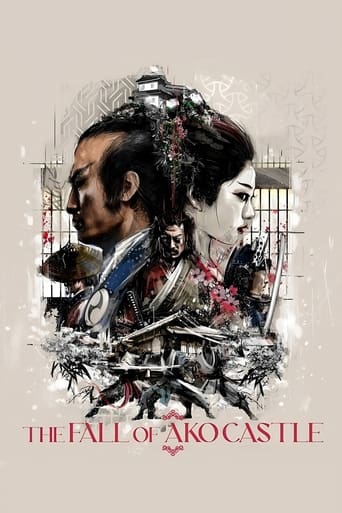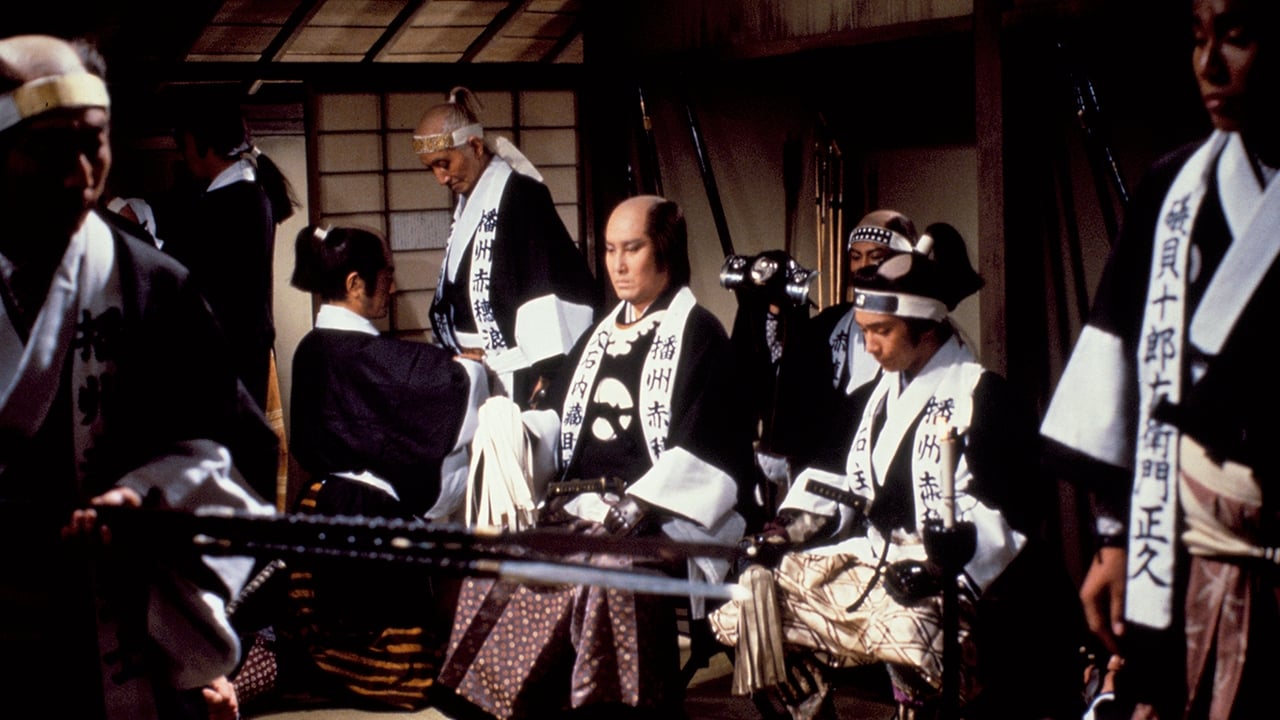Brian Camp
THE FALL OF AKO CASTLE (1978) is yet another version of the story of the 47 Ronin, a historical event that has resonated in Japanese popular and literary culture for the last 300 years. If you want to try to understand Japanese culture and the Japanese character, a good place to start would be this story and the different versions of it that have been written and filmed over the decades. This film, directed by Kinji Fukasaku for the Toei Studio, is the third version I've seen (with three more waiting) and it compares quite favorably with the others, Kunio Watanabe's THE LOYAL 47 RONIN (1958), done at Daiei and also reviewed on this site, and CHUSHINGURA (1962), done at Toho. All three versions are spectacular productions and highly recommended, but I tend to like the 1958 film best because it explicitly enunciates many of the key details that westerners would need to know to understand the incident and its aftermath. Specifically, it devotes its first 20 minutes to the build-up to the incident that caused so much trouble and led to the downfall of the Asano clan, i.e. Lord Kira's insults directed at Lord Asano and Asano's violent reaction in the Shogun's castle, a violation of court etiquette so severe it results in Lord Asano's death. We understand exactly what happened and why. In Fukasaku's version, the incident is handled rather quickly and gotten out of the way in the film's opening scene, so it helps to have seen the other versions first. Fukasaku's overarching emphasis is on the grieved reactions of the samurai in Asano's clan. We see how the incident and the death of their lord impacted them and how they reacted emotionally. There is some time spent on other factions and other affected parties, but not much. The overwhelming emphasis is on the men and their emotional states during the long build-up to the eventual raid on Lord Kira's residence and the mission of revenge. As such, I found the whole thing very affecting and there are moments during the big finale (which lasts at least a half-hour) when an audience at a screening, especially during the glory days of Japanese film festivals in Manhattan, would have erupted into cheers and applause.This film has a formal beauty that one doesn't always find in Fukasaku's films. His Yakuza films of the 1970s are filled with gritty street-level cinematography and hand-held camera movement, particularly in the action scenes. There's a whole different aesthetic at work, for the most part, in THE FALL OF AKO CASTLE. The compositions are beautifully lit and designed, boasting a quality that would compare with the visual elegance in both of the cited previous versions of this tale. On the other hand, he brings an occasional chaotic quality to the action sequences and scenes of men in conflict and turmoil that echoes such elements in his Yakuza films. Violence in Fukasaku is rarely choreographed; it's usually quite messy—just like in real life. However, there are moments in the final battle here, particularly when Sonny Chiba goes into action, that are quite artfully staged.Kinnosuke Nakamura (billed as Kinnosuke Yorozuya for some reason) plays the lead role here, that of Asano Clan Chief Counselor Oishi, who takes command of the samurai following Asano's death. I've seen him in a number of films and TV shows, although I had to consult his IMDb filmography to remind myself which ones. (He starred in the Lone Wolf and Cub TV series.) He tends to blend into whatever ensemble he's cast in and doesn't stand out as much as some of his more famous co-stars here. These include Sonny Chiba as a former clan swordsman who assigns himself the job of bodyguard to Oishi; Tetsuro Tanba (YOU ONLY LIVE TWICE) as Lord Yanagisawa, who decides the ultimate fate of the 47 Ronin; Mariko Okada as Oishi's wife, and an actress famous for having played Akemi, one of Toshiro Mifune's love interests in the SAMURAI trilogy; and Toshiro Mifune himself, in a two-scene cameo as Lord Tsuchiya, who occupies the estate adjacent to Lord Kira and makes his position known once the raid begins. I am quite certain that the old samurai-loving crowd at Japanese film festivals in Manhattan in the 1970s would have burst into applause when Toshiro Mifune makes his first appearance here and again when he makes his declaration of support for the raiders. An audience today would just sit there with blank stares while a handful of us old-timers in the crowd would applaud wildly. I must confess I was unfamiliar with most of the other actors cast in key roles here.As you can tell, I do wish I'd seen this in a theater with a large, enthusiastic audience. As it stands, I had never even heard of this film until I came across the DVD, under the title SWORDS OF VENGEANCE, in a sale bin at my local FYE (it was $1.78!). Why had this never gotten distribution in the U.S.? And when Adness released it on DVD, how did it slip under my radar? It definitely should be better known.As for other versions of the 47 Ronin, I have yet to see Kenji Mizoguchi's epic filming of it, made during WWII, or Kon Ichikawa's 1994 rendering. As a completist, I plan to also see Keanu Reeves' 2013 fantasy version, although I have doubts about its fidelity to the source material. There's also a famous TV dramatization from 1971, "Dai Chushingura," also starring Mifune, but I don't know if we'll ever see a subtitled version of it.
ace-150
Since the 1962 "Chushingura - Hana no maki yuki no maki" is one of my favorite films, I was expecting this to compare unfavorably, but I really enjoyed it. Keeping the focus on Oishi gives a really different flavor than the true ensemble structure of Chushingura. I think that reducing the number of major characters makes it a little easier to understand, but if you didn't grow up hearing the story, it's going to be a bit confusing. How fantastic would it be if there were a separate film telling the story from the perspective of each of the 47 ronin? It's quite beautifully filmed and makes good use of color to set the mood, particularly with the white funerary costumes at the end. I actually liked the 70's wawa music at the beginning, partly because it made me think of Lone Wolf and Cub.
counterrevolutionary
I rented this movie in spite of Fukasaku's name, so I'm perhaps not the most objective judge. In fact, it turned out not to be as bad as I expected, particularly after the completely inappropriate 70s cop-movie theme music. (I kept expecting one of the investigators to slam Asano up against the wall and ask him if he'd ever picked his feet in Kamakura.) But it's still basically a Fukasaku movie. Where it's a straight retelling of the 47 Ronin story, it's OK. Where Fukasaku inserts his own special brand of action melodrama, it's not; I defy anyone to sit through the murder-suicide scene without laughing.The climax is considerably more Sonny Chiba than Chushingura, and I don't mean that as a compliment.And how much did Toei Studios have to shell out to get Toshiro Mifune for a role that could easily have been played by a bit player who would have been glad to do it for scale? It's not that his presence makes the movie worse, exactly, it's just that...why is he there?
alice_frye
This is director Kenji Fukasaku's contribution to the 47 Ronin story, and it represents something of a combination of Mizoguchi's 1941 version and the 1962 version from director Inagaki. Supposedly, Fukasaku wanted to turn the much loved story on its head, but star Kinnosuke Yorozuya used his then extremely high influence with the studio to keep the traditional telling. Fukasaku did get his way with the fight scene, which was choreographed and led by Sonny Chiba, so viewers can expect lotsa action.Lord Asano is not as well fleshed out as he is in Inagaki's effort, so you learn more about the depth of the insult and its significance from the remarks of his loyal samurai. Kira's greedy and conniving personality, so wonderfully conveyed in Inagaki's film, are also less emphasized. Strong supporting performances are delivered by Hiroki Matsukata (the stuttering Shogun Iemitsu in "Shogun's Samurai",) the ubiquitous Tetsuro Tamba and one of my personal favorites, Mikio Narita (the chess player in "Zatoichi and the Chess Expert".) Mifune has a small, but critical role, as well.The movie is a visual treat for fans of jidai-geki (period films,) and maintains a better pace than the 90 minute longer film from 1941. But I recommend seeing Inagaki's "Chushingura," first, if you are not familiar with the remarkable 47 Ronin. Then pick up "The Fall of Ako Castle" for the fight scenes.


 AD
AD









